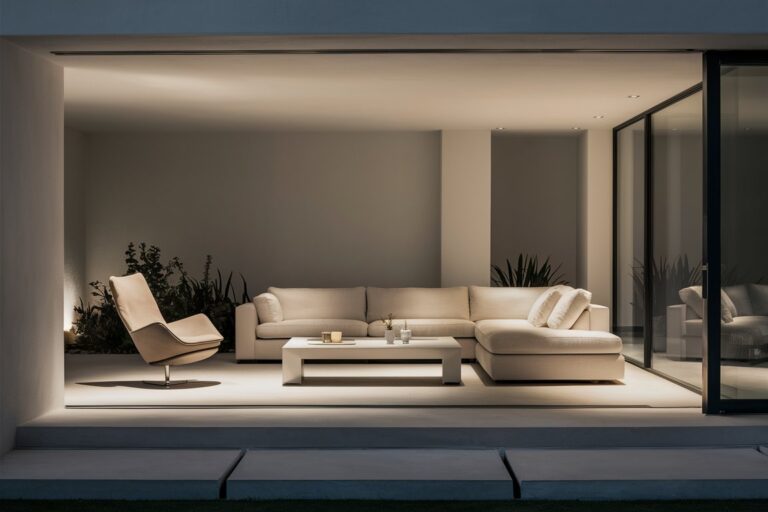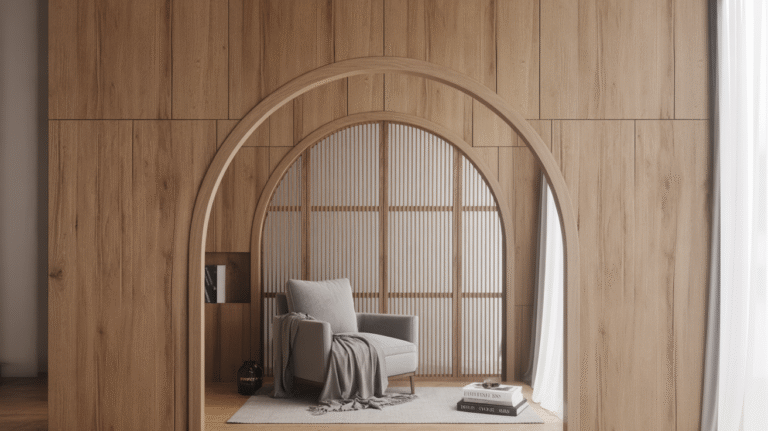Mid Century Living Room Design Ideas That Boost Home Value
This site contains affiliate links. I may earn a small commission, at no extra cost to you.
The Charm (and Genius) Behind a Mid Century Living Room
Alright, let’s be honest for a second—the Mid Century Living Room trend isn’t new. It’s been around for decades. Yet somehow, it keeps sneaking back into our Pinterest boards and home renovation plans like that one ex you swore you were over.
But unlike that ex, mid century design actually gets better with time.
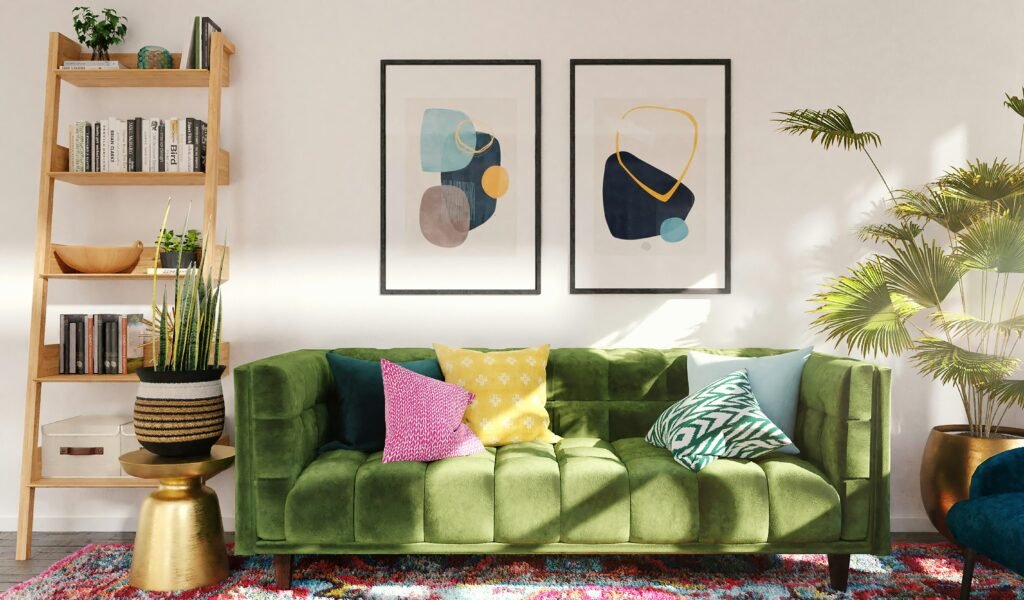
In my experience as an interior designer, a well-styled Mid Century Living Room doesn’t just look incredible—it instantly boosts home value. The style’s clean lines, open layouts, and organic textures speak to both comfort and sophistication. And let’s face it—who doesn’t want their living room to say, “I’m classy but also super chill”?
But before you go hunting for an Eames chair or ordering teak furniture online, let’s talk about what actually makes this design style so timeless—and why buyers and decorators alike can’t get enough of it.
What Exactly Defines a Mid Century Living Room?
If you’ve ever seen Mad Men, you’ve seen mid century design in action. Think sleek furniture, muted tones with bold accents, wooden textures, and geometric shapes.
But the magic of a Mid Century Living Room goes way beyond aesthetics. It’s about creating a space that feels intentional—every curve, every color, every fixture serves a purpose.
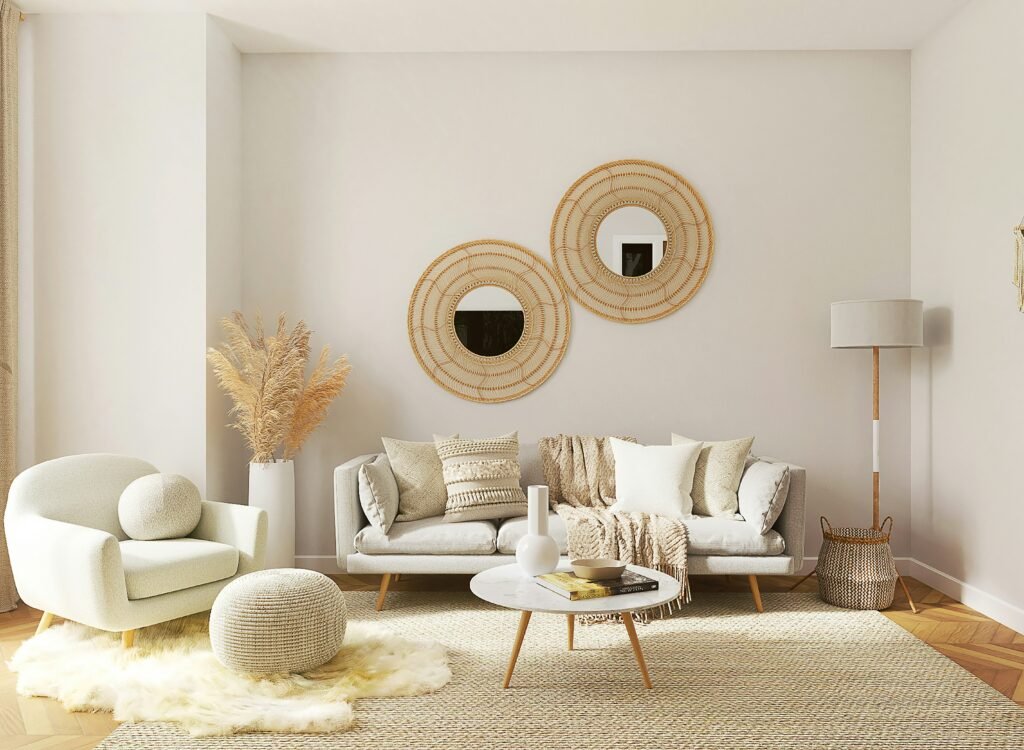
In my opinion, the best way to understand mid century style is to break it down into its essentials:
- Clean lines and minimal clutter: The furniture has structure, but it’s never bulky. Everything feels open and airy.
- Natural wood tones: Teak, walnut, and oak dominate the palette. These woods add warmth and timeless appeal.
- Earthy and retro hues: Mustard yellow, olive green, burnt orange—colors that remind you of nature but with a retro punch.
- Functional furniture: Every piece looks like it belongs in an art gallery but still feels cozy enough to lounge on.
- Statement lighting: Iconic floor lamps, Sputnik chandeliers, and globe pendants make a bold yet balanced statement.
According to my experience, this combination creates a perfect middle ground—a room that feels both modern and nostalgic. It’s simple without being boring, elegant without being overdone. And that’s exactly why it continues to add real value to homes even today.
Why Homebuyers Love a Mid Century Living Room
Ever wondered why realtors practically drool over homes with mid century living rooms?
It’s not just about the look. It’s about what that look says.
A Mid Century Living Room gives off an air of refined taste—the kind of space that feels effortlessly stylish, not desperately trendy.
In my experience, when buyers walk into a mid century-inspired living area, they immediately sense quality, craftsmanship, and personality.
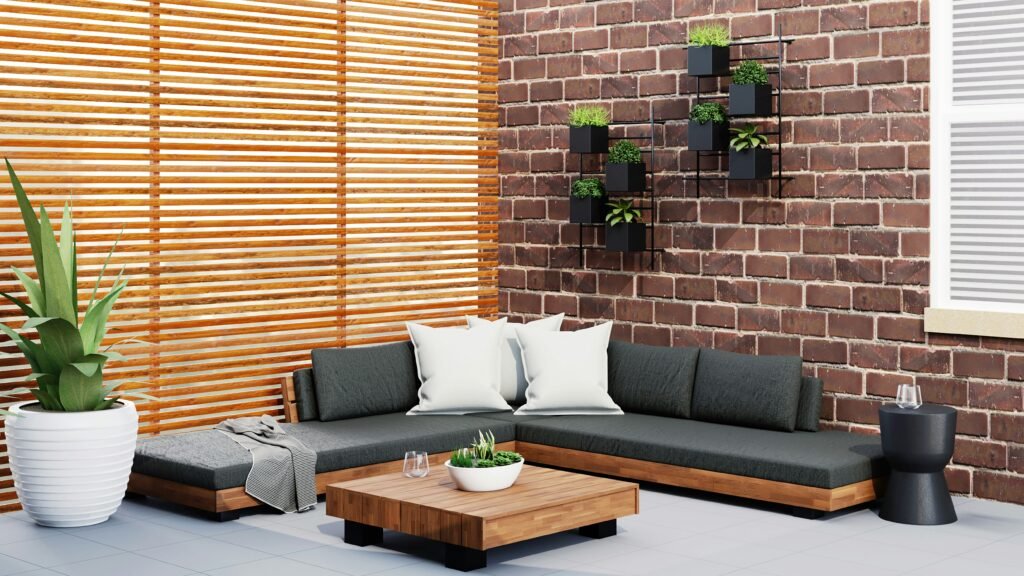
Here’s what makes it so irresistible:
- It photographs beautifully. Real estate listings love light-filled, structured rooms, and mid century layouts practically pose for the camera.
- It’s timeless. While other design trends scream “2022 Pinterest board,” this one whispers, “classic sophistication.”
- It complements multiple styles. You can easily blend it with boho, Scandinavian, or even minimal decor without losing its soul.
- It suggests thoughtful design. Buyers assume (rightfully so) that someone who decorated in mid century taste probably took good care of the rest of the home.
I’ve personally seen listings with just a few mid century tweaks—like changing the lighting or adding a walnut sideboard—sell faster and at higher prices. The design creates an emotional connection; people imagine themselves sipping coffee there, flipping through magazines, or hosting effortlessly cool dinner parties.
And emotional connection? That’s gold in real estate.
The Psychology Behind Mid Century Appeal
Here’s something most people overlook—mid century design taps into human psychology.
It’s not just about looks; it’s about how the space feels to live in.
The clean lines and symmetry calm the brain. The organic materials (like wood and leather) create a sense of connection to nature. And those vibrant accent colors? They stimulate creativity and joy.
So when someone steps into a Mid Century Living Room, they subconsciously feel at ease—energized yet relaxed.
In my opinion, that’s why this style works wonders for both resale and personal enjoyment. You’re not just creating a “decorated” space; you’re building an experience.
Think of it this way: a chaotic or overly ornate room demands attention.
But a mid century living room invites you to breathe. It tells you, “Sit down. You’re home.”
The Core Elements of a Perfect Mid Century Living Room
Now that we’ve covered the “why,” let’s move into the “how.”
Because while the philosophy behind mid century design is beautiful, execution matters even more.
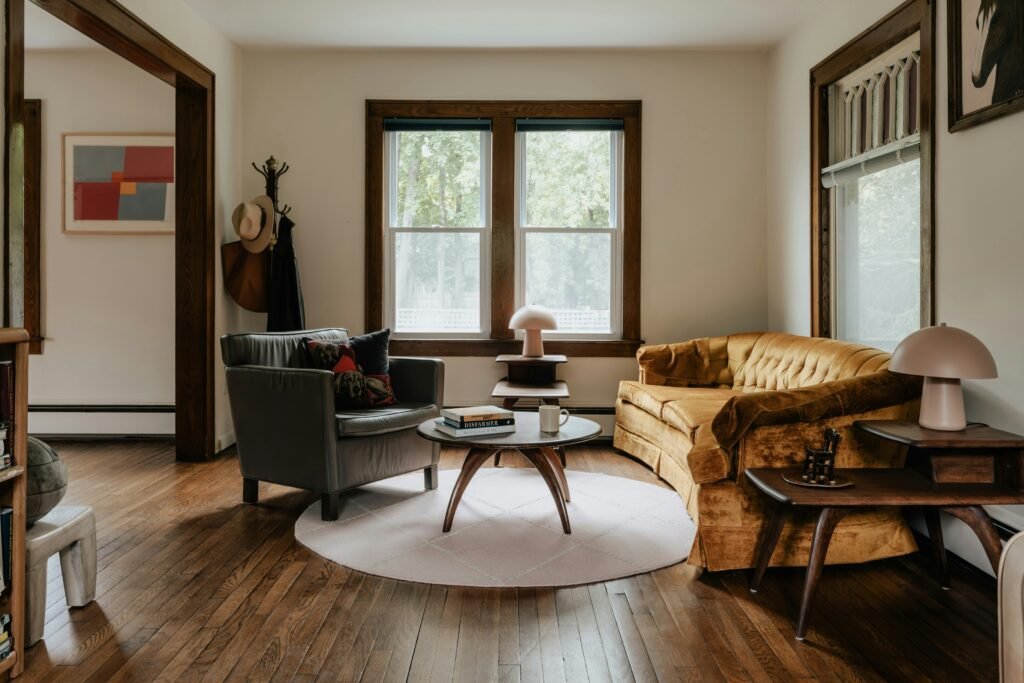
When I style a Mid Century Living Room, I focus on five foundational pillars:
- Furniture Shape: Look for tapered legs, low profiles, and clean edges. A walnut coffee table with hairpin legs? Absolute classic.
- Materials: Wood, leather, glass, and metal should coexist naturally. I like to mix wood with sleek metal accents for balance.
- Color Palette: Stick to neutrals (like beige, white, or gray) as your base, then add one or two statement hues—maybe mustard or turquoise.
- Lighting: Never underestimate lighting. In my opinion, a single sculptural pendant can elevate the entire space.
- Accessories: Go minimal but intentional. A few ceramic vases, abstract art pieces, or geometric rugs can tie the look together.
Each of these elements serves one goal—to make the space feel cohesive, intentional, and quietly luxurious.
And the best part? You don’t need a huge budget to make it happen. Small tweaks often have the biggest impact (trust me, I’ve done full transformations with just a few pieces of new furniture and lighting).
Common Mistakes People Make with Mid Century Living Rooms
Ah, yes—the “Pinterest fails” of the mid century world.
You’ve probably seen them: rooms with so much brown wood it looks like a tree exploded, or ones cluttered with too many “retro” knick-knacks that feel more thrift store than timeless.

Let me share a few things I’ve learned not to do (the hard way, might I add):
- Overdoing the theme: Mid century is about balance, not replication. You don’t need to turn your living room into a 1950s museum.
- Ignoring scale: Furniture that’s too bulky or too tiny ruins the proportion. Stick to pieces that feel airy but grounded.
- Clashing colors: Those retro hues are bold, yes—but they should complement, not compete.
- Forgetting modern comfort: In my opinion, style means nothing if the sofa isn’t comfortable. Choose designs that merge vintage looks with modern usability.
If you can avoid these pitfalls, you’ll already be halfway to a stunning mid century space that feels both authentic and livable.
Choosing the Right Furniture: Where Comfort Meets Character
Okay, let’s start with the heart of every Mid Century Living Room—the furniture.
Because let’s be honest, even the best wall art can’t save a room if your sofa looks like it time-traveled from a college dorm.
In my experience, the beauty of mid century furniture lies in its simplicity with purpose. Every piece is sleek, sculptural, and functional without screaming for attention. It’s that quiet confidence I personally find irresistible.
Here’s what I recommend focusing on when furnishing your space:
1. The Sofa: Keep It Sleek and Structured
If your living room were a movie, the sofa would be the lead actor.
Look for low-profile designs with clean lines—think tufted backs, slim wooden legs, and a neutral fabric that doesn’t overpower the room.
In my opinion, a walnut or oak base instantly brings warmth and authenticity. I love pairing a beige or olive green fabric with a wood frame for that effortless mid century balance. Bonus tip? Choose a style that feels comfortable enough for movie nights yet stylish enough to impress guests.
2. The Coffee Table: Functional Art
Ever noticed how mid century coffee tables look like they belong in an art gallery? That’s the point.
The best ones combine organic curves with geometric precision—oval shapes, glass tops, or triangular silhouettes.
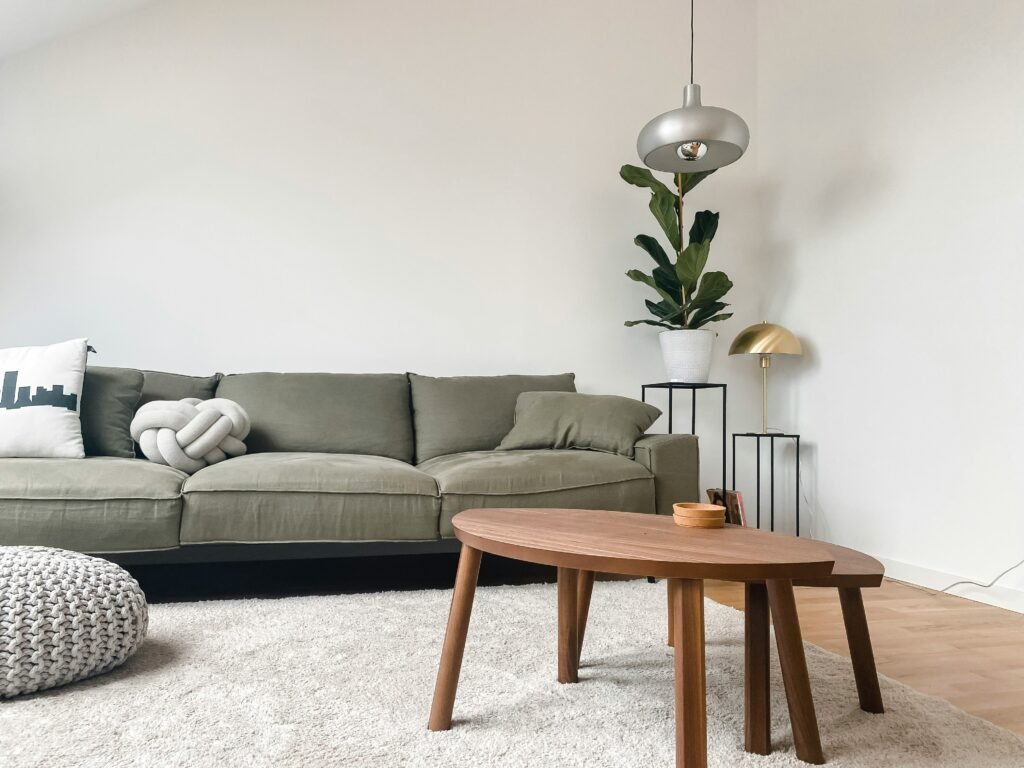
According to my experience, the Noguchi-style coffee table is practically iconic for this aesthetic. Its sculptural wooden base adds interest without clutter. But if you want something practical, go for a two-tier table that doubles as storage. It’s form and function living happily ever after.
3. Accent Chairs: The Show-Stealers
Now, let’s talk about the unsung heroes—accent chairs.
I personally believe that a pair of statement chairs can transform your entire Mid Century Living Room from “nice” to “Pinterest-worthy.”
Go for tapered wooden legs, curved silhouettes, or leather upholstery. I recommend adding one in a bold hue—like mustard or teal—to break up the monotony. It’s like adding personality without shouting.
4. Media Console: The Underestimated Essential
I’ve seen so many homes where people spend big on sofas and lighting but totally overlook the TV stand. Big mistake.
A sleek, wood-toned media console with sliding doors not only hides clutter but also grounds the space.
I personally prefer long, low consoles in walnut with brass or matte black hardware. They anchor the room and make it look more expansive—an easy win for both style and value.
Styling That Adds Value (Without Breaking the Bank)
Here’s the good news: you don’t need to buy every vintage piece on Etsy to nail the mid century vibe.
Sometimes, small, strategic updates can make your space feel more authentic—and yes, add to your home’s resale appeal.
1. Layer with Texture, Not Clutter
One of the biggest misconceptions about mid century design is that it’s sterile or “too minimal.”
In my opinion, it’s the opposite. It’s warm, layered, and full of subtle depth.

Here’s what I like to mix in:
- Rugs: Go for geometric or textured weaves in neutral or muted tones.
- Throws and cushions: Choose velvet, wool, or linen—materials that feel natural and inviting.
- Curtains: Light, airy fabrics like sheer cotton or linen let sunlight do its magic.
Remember, texture should whisper, not shout. You’re aiming for “cozy chic,” not “flea market explosion.”
2. Statement Lighting: Your Secret Weapon
Lighting can make or break your Mid Century Living Room, and I’ve seen it happen more times than I’d like to admit.
If you invest in just one design-forward element—make it lighting.
My personal favorites:
- Sputnik chandeliers: The definition of mid century drama (in a good way).
- Tripod floor lamps: Perfect for corners that need height and presence.
- Globe pendants: Soft, diffused light that feels timeless.
And please, for the love of good taste—ditch harsh white bulbs. Warm light adds that vintage glow that makes wood tones and fabrics pop.
3. Art and Accessories That Tell a Story
You know what instantly gives away a poorly styled space? Generic wall art.
Your living room should tell your story, not look like a hotel lobby.

I recommend:
- Abstract prints with geometric shapes or muted tones.
- Vintage posters from the 50s–70s (they’re conversation starters).
- Ceramic vases or planters that add organic softness.
In my opinion, mid century styling works best when it feels collected—not staged. So don’t buy all your decor in one weekend. Let it evolve with you.
The Perfect Mid Century Layout (According to My Experience)
Designing a beautiful room is one thing. Designing a functional one? That’s where most people struggle.
The Mid Century Living Room philosophy emphasizes flow and openness. So instead of lining furniture up against the walls, create conversational clusters.
You want the room to invite interaction.
Here’s what I usually recommend:
- Anchor with a rug. It defines the zone and keeps furniture visually connected.
- Float the sofa. If space allows, pull it slightly away from the wall—it gives instant depth.
- Balance with symmetry. Pair armchairs opposite the sofa or angle them toward the center.
- Leave breathing room. Always keep walking paths open (trust me, bumping into coffee tables gets old fast).
In my experience, the layout is what makes or breaks that high-end feel. Even budget furniture can look luxurious if it’s arranged thoughtfully.
Color Palettes That Scream “Mid Century” (In the Best Way)
Let’s talk color—because, in my opinion, this is where many people either nail the look or completely derail it.
The key? Balance warmth with restraint.
Mid century interiors usually start with a neutral base and then introduce one or two bold accents.
Some of my favorite combinations include:
- Olive green + walnut wood + cream (my all-time favorite combo)
- Mustard yellow + charcoal gray + white
- Teal + beige + walnut
- Terracotta + ivory + black accents
A word of advice? Don’t go overboard. You want your space to hint at retro vibes, not scream “1960s diner.”
If you’re nervous, start small—introduce color through pillows, art, or a single statement chair.
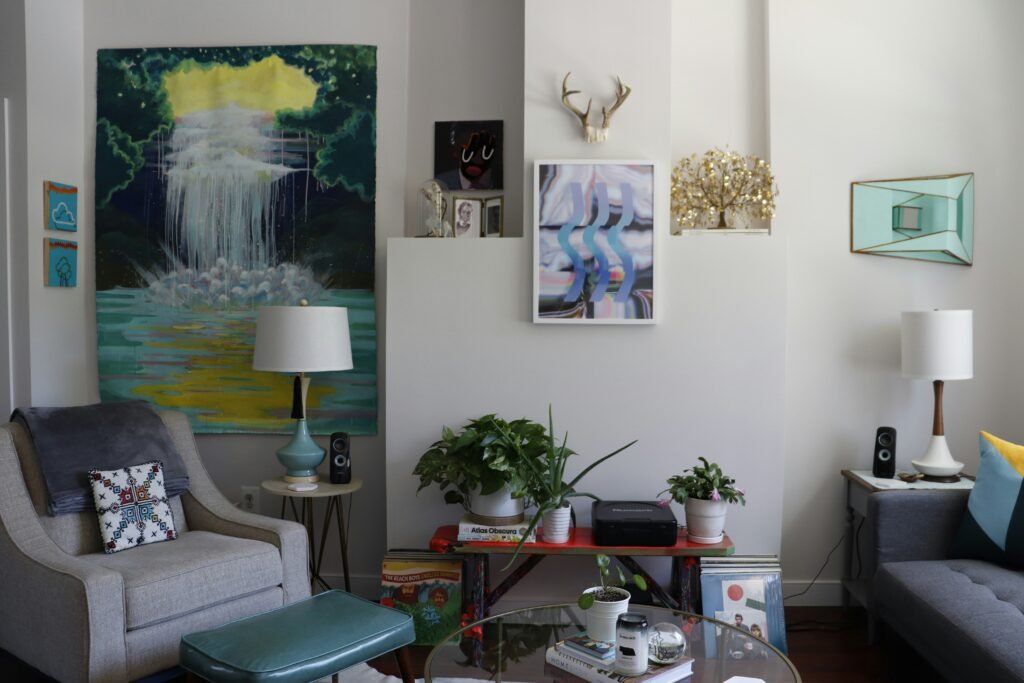
How Lighting, Layout, and Color Work Together
Here’s the thing: no single design element works in isolation.
When your lighting, color palette, and furniture layout align, the entire room feels cohesive—and that’s what gives off “expensive home” energy.
In my experience, buyers (and guests) may not consciously notice why a Mid Century Living Room feels good—but they feel it. The harmony, the proportions, the warmth—it’s all subconscious.
And when people emotionally connect to a space, they’re more likely to see its value.
Budget-Friendly Mid Century Design Tips
I get it—not everyone wants to spend thousands on designer furniture. Luckily, you don’t have to.
Here are a few tricks I use to get the look without draining your wallet:
- Thrift smart. Vintage stores and Facebook Marketplace are goldmines. Look for wood frames and reupholster later if needed.
- DIY your art. Abstract mid century art is surprisingly easy to make with some canvas and acrylics.
- Swap handles. Upgrading hardware on furniture can make budget pieces look high-end.
- Layer lighting. Combine floor lamps, sconces, and pendants instead of relying on one overhead light.
- Mix old and new. I often blend IKEA basics with one or two vintage statement pieces. It keeps things affordable and interesting.
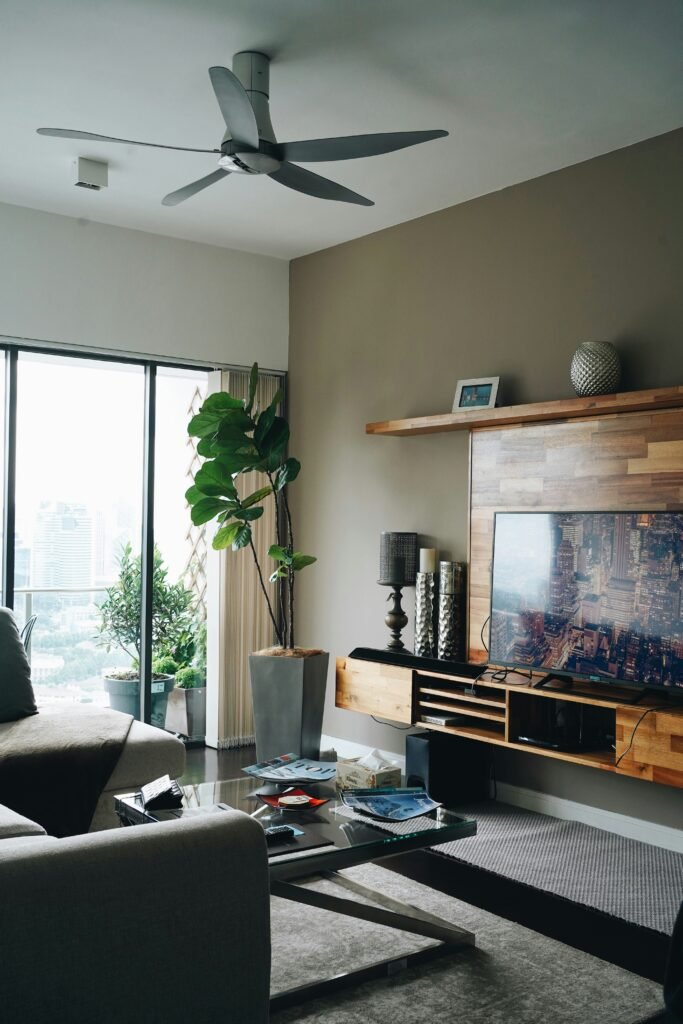
In my opinion, mid century design rewards creativity—not just spending power. The charm comes from curation, not perfection.
The Finishing Touches That Make Your Mid Century Living Room Shine
You’ve got the furniture. You’ve nailed the layout. You’ve balanced your color palette.
But here’s the truth I’ve learned after years in design — it’s the finishing touches that make or break the entire space.
In my opinion, this is where you move from “pretty room” to “professionally styled living space.” And the best part? You don’t need a huge budget to do it right.
Let’s talk about the elements that subtly whisper luxury to every visitor who walks in (or every homebuyer scrolling through listing photos).
1. Add a Few Plants — But Make Them Count
I’ll say it: no Mid Century Living Room feels complete without a touch of green. Plants balance all that wood and structure with life and movement.
Some of my go-to picks:
- Fiddle Leaf Fig: Big, sculptural, and effortlessly chic.
- Snake Plant: Sleek and low maintenance.
- Monstera: Those bold leaves scream mid century cool.

Place one in a vintage ceramic planter or a simple terracotta pot — nothing too fussy.
In my experience, greenery instantly softens the room and adds that lived-in warmth buyers crave.
2. Layer the Lighting Like a Pro
If there’s one thing I’ve learned in interior design, it’s that lighting can double your home’s perceived value.
Seriously, people feel the difference even if they can’t explain it.
You want layers:
- Ambient lighting (your main light source)
- Task lighting (reading lamps, sconces)
- Accent lighting (spotlights, uplights, or art lighting)
In my opinion, a dimmable setup is a total game-changer. It lets you shift from “bright and airy” to “moody and elegant” with one touch.
Oh, and never underestimate a well-placed floor lamp. It can anchor an awkward corner like nothing else.
3. Mix in Personal Touches (Without Losing Cohesion)
Here’s where many people overdo it. Yes, your home should reflect you — but it still needs a cohesive vibe.
According to my experience, I always tell clients: personal doesn’t mean random.
Instead of cluttering shelves with every souvenir you own, choose a few meaningful objects — travel books, ceramic sculptures, framed art from local artists.
They should feel intentional, not accidental.
A personal touch I like? Adding one vintage photograph in a brass frame. It’s subtle, elegant, and connects your modern home to the nostalgia mid century design celebrates.
How to Blend Mid Century with Other Styles (Without Creating Chaos)
Okay, let’s get real — most people don’t want their home to look like a 1950s time capsule. You might love mid century design but also have a soft spot for farmhouse charm or modern minimalism.
Totally fine. I’ve blended mid century with everything from industrial lofts to coastal cottages, and it works beautifully — if you know how.
Here’s what I recommend:
1. Combine with Scandinavian Simplicity
Both styles love clean lines and natural materials.
Use light wood tones, linen fabrics, and simple silhouettes.
In my opinion, this pairing feels calm, bright, and universally appealing.
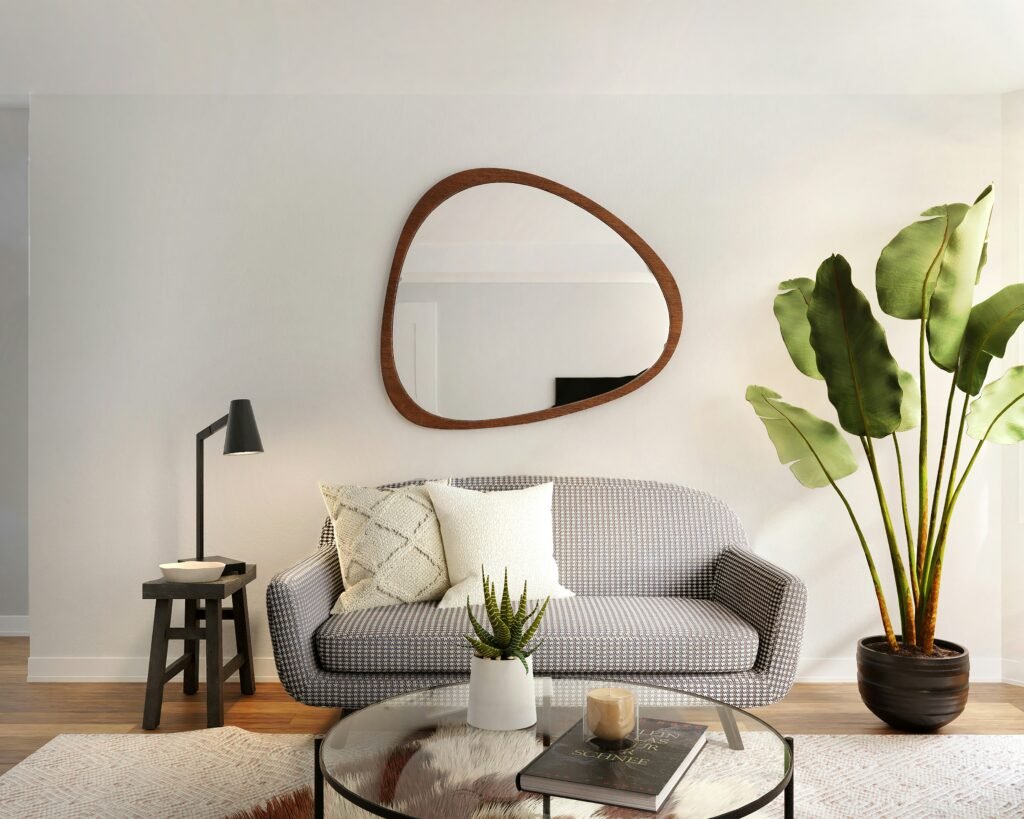
2. Add a Touch of Boho Warmth
Mid century structure + bohemian texture = magic.
Throw in woven baskets, macramé wall hangings, or a jute rug. Just keep the color palette earthy to avoid visual overload.

3. Bring in Modern Glam (Subtly)
If you like a bit of shine, I recommend brass or gold accents.
Think metallic light fixtures, a gold-rimmed mirror, or bar cart accessories. It elevates the mid century look without losing its soul.
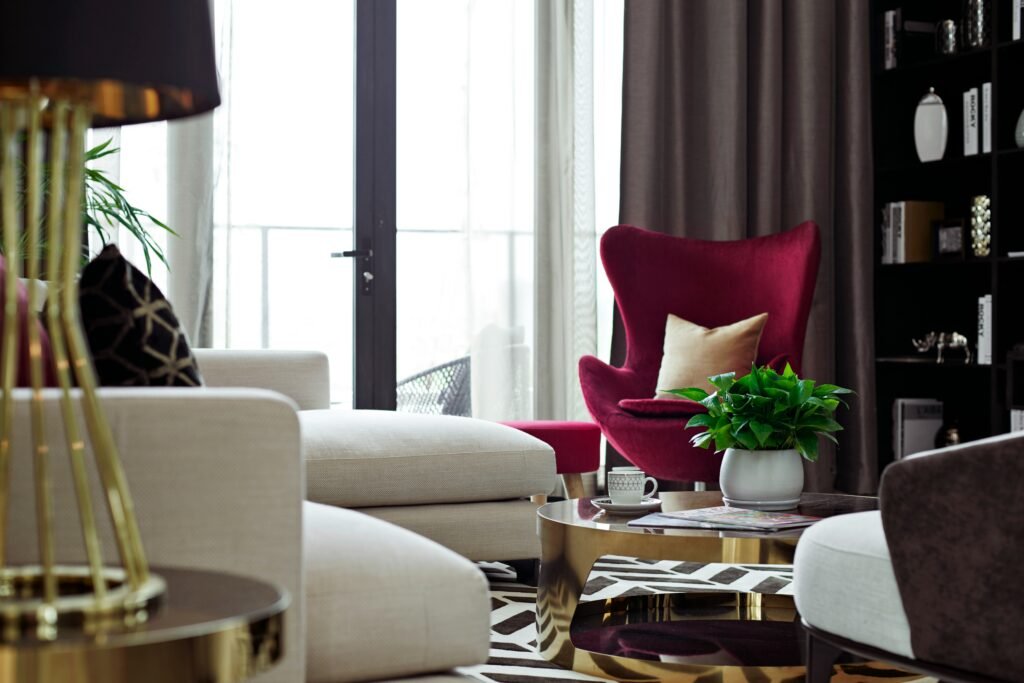
4. Blend with Industrial Edge
For a bolder aesthetic, pair mid century furniture with exposed brick, black metal, and matte finishes.
I love how the warm wood contrasts with cool, urban materials. It’s sophisticated yet grounded.
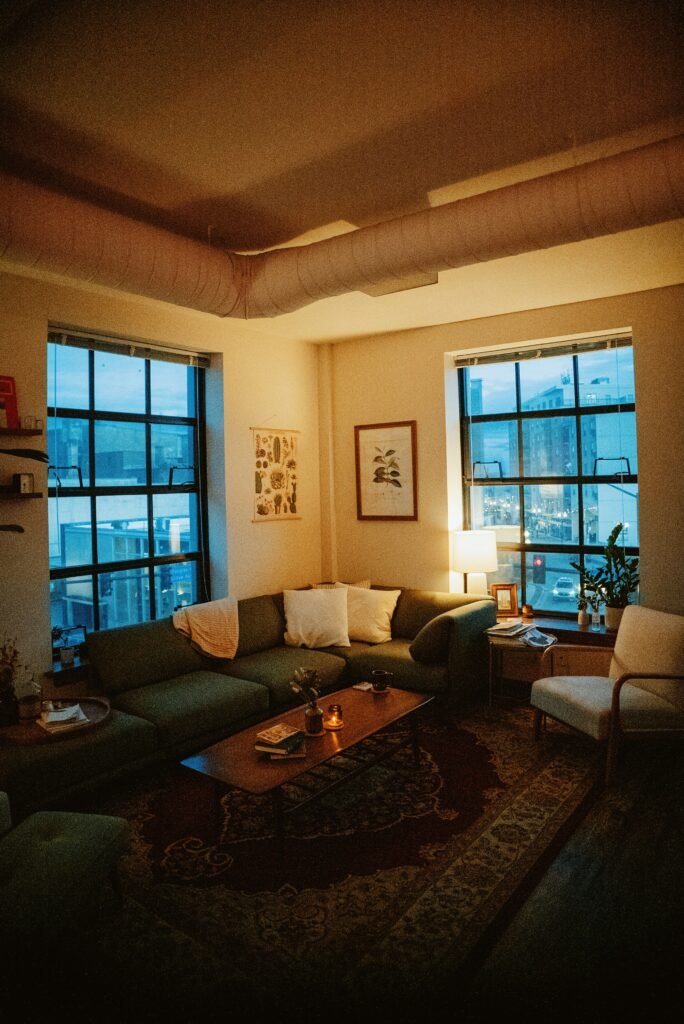
Remember: choose one dominant style (in this case, mid century) and let the others complement it.
Otherwise, your space risks feeling confused — and confused doesn’t sell.
The Value Factor: Why Mid Century Design Pays Off
Let’s talk numbers for a moment (yes, the part everyone secretly cares about).
In my professional opinion, a Mid Century Living Room doesn’t just make your home look good — it makes it worth more.
Here’s why:
- Timeless appeal. Mid century design feels stylish in any decade, so buyers don’t think about “updating” it immediately.
- Perceived quality. Natural wood, solid craftsmanship, and cohesive design give the impression of a well-built home.
- Versatility. The style complements most architectural layouts, which broadens your buyer pool.
- Emotional connection. Buyers imagine themselves relaxing there — and emotional attachment sells faster than logic.
In my experience, listings with mid century-inspired living rooms often photograph better and attract more views online.
You can literally watch the engagement jump — because who can resist clicking on a room that looks like it belongs in a design magazine?
Small Upgrades That Boost Home Value Instantly
You don’t have to gut your living room to get that value bump. Sometimes, a few smart updates do the trick.
Here are some of my tried-and-true changes that give maximum impact with minimal cost:
- Upgrade the lighting fixtures: Replace basic flush mounts with mid century pendants or floor lamps.
- Refinish old furniture: A simple walnut stain or matte varnish can make a world of difference.
- Change hardware: Swap plastic knobs for brushed brass or matte black. It’s a subtle but powerful transformation.
- Add a rug: A geometric rug instantly ties the room together.
- Style your shelves: Mix books, ceramics, and greenery in balanced clusters.
In my opinion, these small details collectively elevate your home’s perceived quality — and that’s exactly what buyers notice.
Why the Mid Century Living Room Will Never Go Out of Style
Every few years, someone claims mid century design is “over.” Then a few months later, it’s everywhere again.
Honestly, I don’t see it disappearing — ever.
Why? Because it nails what people want in a home:
simplicity, function, comfort, and beauty.
In my opinion, the best design trends don’t just follow fashion — they follow feeling.
And the mid century aesthetic makes you feel good. The proportions are balanced, the light flows naturally, and the textures invite you to touch them.
Even after four years in design, I still get excited every time I work on a Mid Century Living Room project. There’s something timeless about how effortlessly it blends nostalgia with modern life.
Pro Designer Tips (From My Personal Playbook)
To wrap things up, here are a few of my personal mid century living room tips that consistently deliver results:
- Always start with the layout. Design starts with flow, not color.
- Mix old and new. Authentic vintage pieces bring soul; new ones bring comfort.
- Don’t over-accessorize. Leave breathing room — mid century is all about visual clarity.
- Match tones, not colors. Warm wood pairs beautifully with warm fabrics; cool tones clash.
- Use mirrors strategically. A large, rounded mirror expands light and space instantly.
- Invest in lighting. Even one stunning chandelier can transform your room’s vibe.
In my opinion, mid century design isn’t about chasing perfection — it’s about finding balance. When you mix clean shapes, organic materials, and intentional choices, the result feels timeless.
Final Thoughts: Design with Heart, Not Just Trends
At the end of the day, a Mid Century Living Room isn’t just a trend or a resale trick — it’s a mindset. It’s about appreciating craftsmanship, welcoming light, and celebrating simplicity.
Whether you’re redesigning your home for yourself or prepping it for sale, this style is one of the smartest moves you can make. It adds value, yes — but it also adds soul.
And honestly, in my opinion, that’s the real win.
Because while trends fade, a space that feels warm, functional, and beautiful? That never goes out of style.
So go ahead — roll up your sleeves, bring in that teak coffee table, hang that vintage pendant, and start creating the mid century living room your home (and future buyers) will thank you for.




